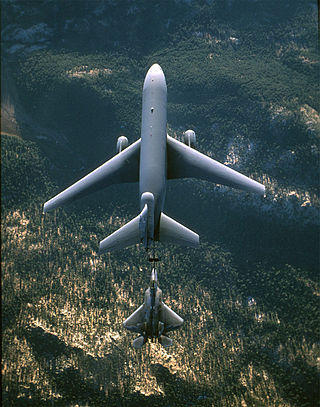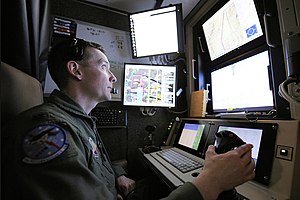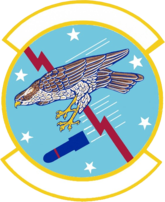
The 39th Air Base Wing is a United States Air Force unit assigned to the Third Air Force. It is stationed at Incirlik Air Base, Turkey. The wing is also the host unit at Incirlik.

The 70th Intelligence, Surveillance and Reconnaissance Wing is a United States Air Force unit assigned to the 16th Air Force. It is stationed at Fort George G. Meade, Maryland.

The 58th Air Division is an inactive United States Air Force unit. Its last assignment was with Air Defense Command, based at Wright Patterson Air Force Base, Ohio. It was inactivated on 1 February 1959.

The 468th Bombardment Group was a World War II United States Army Air Forces combat organization. The unit served primarily in the Pacific Ocean theater and China Burma India Theater of World War II as part of Twentieth Air Force. The 468th Bomb Group's aircraft engaged in very heavy bombardment Boeing B-29 Superfortress operations against Japan. After its reassignment to the Mariana Islands in 1945, its aircraft were identified by a "I" and a triangle painted on the tail. It was inactivated on 31 March 1946.

The 512th Rescue Squadron is part of the 58th Special Operations Wing based at Kirtland Air Force Base, New Mexico. It formerly operated the Bell UH-1N Twin Huey and currently operates the Sikorsky HH-60G Pave Hawk and the new HH-60W Jolly Green II helicopters training aircrew conducting search and rescue missions.

The 6th Air Refueling Squadron is part of the 60th Air Mobility Wing at Travis Air Force Base, California. It operates the McDonnell Douglas KC-10 Extender aircraft conducting mobility, and air refueling missions.

The 99th Air Refueling Squadron is part of the 6th Air Mobility Wing at MacDill Air Force Base, Florida, but is stationed at Birmingham Air National Guard Base, Alabama. It is an Active Associate Unit, an active duty component attached to the Alabama Air National Guard's 117th Air Refueling Wing. The 99th Air Refueling Squadron works with, supports and flies the 117th Air Refueling Wing's Boeing KC-135R Stratotanker aircraft.

The 319th Missile Squadron is a United States Air Force unit assigned to the 90th Operations Group at Francis E. Warren Air Force Base, Wyoming. The squadron is equipped with the LGM-30G Minuteman III intercontinental ballistic missile, with a mission of nuclear deterrence. It is the flagship squadron of the 90th Missile Wing.

The 65th Special Operations Squadron is an Air Force Special Operations Command unit which flies the General Atomics MQ-9 Reaper at Hurlburt Field, Florida. The squadron was first activated as the 65th Bombardment Squadron in January 1941, one of the original squadrons of the 43rd Bombardment Group. Following the attack on Pearl Harbor, the squadron participated in antisubmarine patrols until January 1942, when it moved to Australia and the Southwest Pacific Theater. It moved forward with US forces through New Guinea and the Philippines, moving to Ie Shima shortly before V-J Day for operations against Japan. It earned two Distinguished Unit Citations and a Philippine Presidential Unit Citation for combat operations. During this period, a crew from the 65th became the most decorated aircrew in United States history, when their B-17 fought off twenty Japanese fighters during a photo reconnaissance mission. The squadron was inactivated in the Philippines in April 1946.

The 307th Operations Group is an Air Reserve Component of the United States Air Force. It is assigned to the 307th Bomb Wing, Air Force Reserve Command, stationed at Barksdale Air Force Base, Louisiana.

The 768th Bombardment Squadron is an inactive United States Air Force unit. It was last assigned to the 462d Strategic Aerospace Wing at Larson Air Force Base, Washington, where it was inactivated on 25 June 1966. The squadron was first activated in 1943, and became one of the earliest Boeing B-29 Superfortress units. It moved to the China Burma India Theater in April 1944 and participated in the first attack on the Japanese Home Islands since the 1942 Doolittle Raid on 15 June 1944. It earned three Distinguished Unit Citations. The squadron moved to Tinian with the rest of the 58th Bombardment Wing in April 1945 and continued its participation in the strategic bombing campaign against Japan until V-J Day. In November 1945, it returned to the United States, where it was inactivated in April 1946.

The 24th Expeditionary Reconnaissance Squadron is a provisional unit of the United States Air Force. It is assigned to United States Air Forces Europe to activate or inactivate as needed. Its last known attachment was to the 100th Air Refueling Wing, stationed at RAF Mildenhall, Suffolk, UK in 2007.

The 513th Electronic Warfare Squadron is a United States Air Force unit assigned to the 350th Spectrum Warfare Group at Eglin Air Force Base, Florida.

The 718th Bombardment Squadron is an inactive United States Air Force unit. It was last assigned to the 4128th Strategic Wing at Amarillo Air Force Base, Texas, where it was inactivated on 1 February 1963.

The 717th Bombardment Squadron is an inactive United States Air Force unit. It was last assigned to the 4245th Strategic Wing at Sheppard Air Force Base, Texas, where it was inactivated on 1 February 1963.

The 68th Air Refueling Squadron is an inactive United States Air Force unit. It was last assigned to the 305th Bombardment Wing at Bunker Hill Air Force Base, Indiana, where it was inactivated on 25 March 1965.

The 920th Air Refueling Squadron is an inactive United States Air Force unit. It was last assigned to the 379th Bombardment Wing at Wurtsmith Air Force Base, Michigan where it was inactivated on 30 September 1992.

The 782nd Tactical Air Support Training Squadron is an inactive United States Air Force unit. The squadron's most distinguished predecessor is the 792nd Bombardment Squadron, which was organized in 1943 as one of the first Boeing B-29 Superfortress units, The squadron participated in the strategic bombing campaign against Japan, earning three Distinguished Unit Citations. It returned to the United States following V-J Day and briefly became one of the first units in Strategic Air Command before inactivating at the end of March 1946.

The 793d Bombardment Squadron is a former United States Army Air Forces unit. The squadron was organized in 1943 as one of the first Boeing B-29 Superfortress units. After training in the United States, The squadron moved to India and participated in the strategic bombing campaign against Japan. When bases in the Mariana Islands became available, the squadron moved to Tinian, where it was able to strike targets in Japan without staging through forward bases. It earned three Distinguished Unit Citations during its combat tour. It returned to the United States following V-J Day and briefly became one of the first units in Strategic Air Command before inactivating at the end of March 1946.

The 902d Expeditionary Air Refueling Squadron is an inactive United States Air Force unit. It was last assigned to the 70th Bombardment Wing at Clinton-Sherman Air Force Base, Oklahoma, where it was inactivated on 31 December 1969.


























